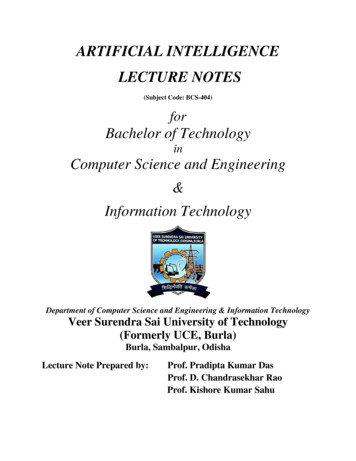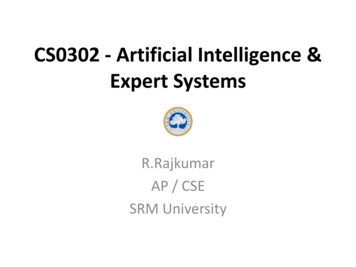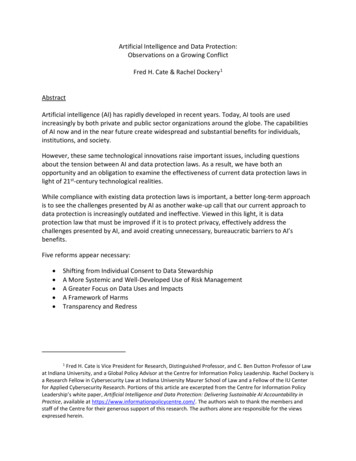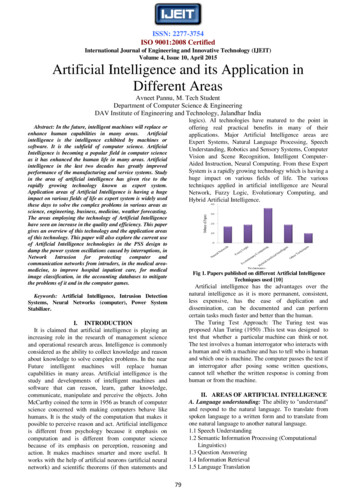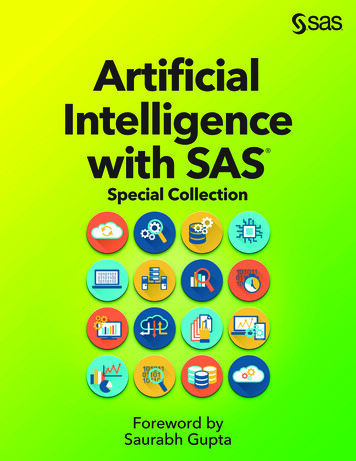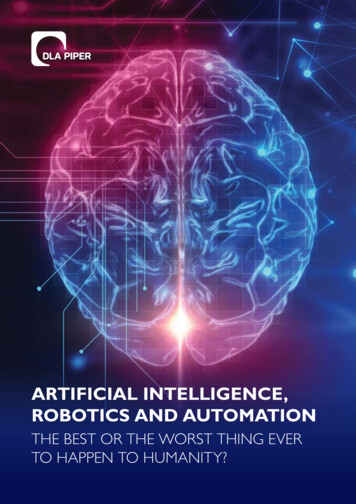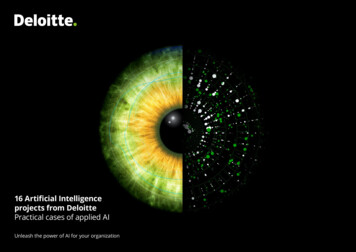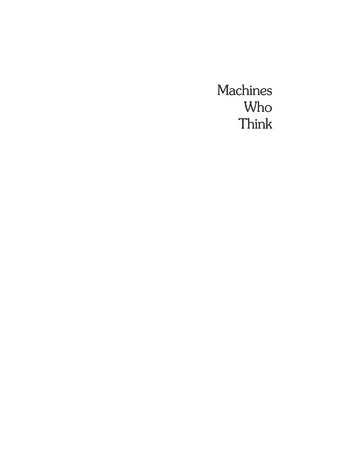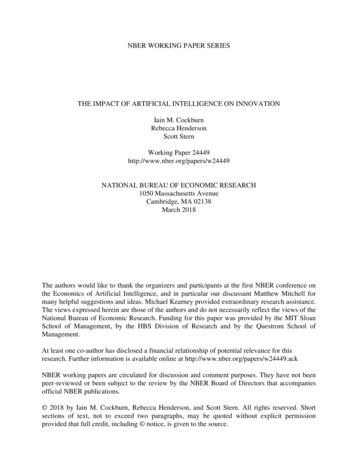
Transcription
NBER WORKING PAPER SERIESTHE IMPACT OF ARTIFICIAL INTELLIGENCE ON INNOVATIONIain M. CockburnRebecca HendersonScott SternWorking Paper 24449http://www.nber.org/papers/w24449NATIONAL BUREAU OF ECONOMIC RESEARCH1050 Massachusetts AvenueCambridge, MA 02138March 2018The authors would like to thank the organizers and participants at the first NBER conference onthe Economics of Artificial Intelligence, and in particular our discussant Matthew Mitchell formany helpful suggestions and ideas. Michael Kearney provided extraordinary research assistance.The views expressed herein are those of the authors and do not necessarily reflect the views of theNational Bureau of Economic Research. Funding for this paper was provided by the MIT SloanSchool of Management, by the HBS Division of Research and by the Questrom School ofManagement.At least one co-author has disclosed a financial relationship of potential relevance for thisresearch. Further information is available online at http://www.nber.org/papers/w24449.ackNBER working papers are circulated for discussion and comment purposes. They have not beenpeer-reviewed or been subject to the review by the NBER Board of Directors that accompaniesofficial NBER publications. 2018 by Iain M. Cockburn, Rebecca Henderson, and Scott Stern. All rights reserved. Shortsections of text, not to exceed two paragraphs, may be quoted without explicit permissionprovided that full credit, including notice, is given to the source.
The Impact of Artificial Intelligence on InnovationIain M. Cockburn, Rebecca Henderson, and Scott SternNBER Working Paper No. 24449March 2018JEL No. L1ABSTRACTArtificial intelligence may greatly increase the efficiency of the existing economy. But it mayhave an even larger impact by serving as a new general-purpose “method of invention” that canreshape the nature of the innovation process and the organization of R&D. We distinguishbetween automation-oriented applications such as robotics and the potential for recentdevelopments in “deep learning” to serve as a general-purpose method of invention, findingstrong evidence of a “shift” in the importance of application-oriented learning research since2009. We suggest that this is likely to lead to a significant substitution away from more routinizedlabor-intensive research towards research that takes advantage of the interplay between passivelygenerated large datasets and enhanced prediction algorithms. At the same time, the potentialcommercial rewards from mastering this mode of research are likely to usher in a period ofracing, driven by powerful incentives for individual companies to acquire and control criticallarge datasets and application-specific algorithms. We suggest that policies which encouragetransparency and sharing of core datasets across both public and private actors may be criticaltools for stimulating research productivity and innovation-oriented competition going forward.Iain M. CockburnSchool of ManagementBoston University595 Commonwealth AveBoston, MA 02215and NBERcockburn@bu.eduRebecca HendersonHeinz Professor of Environmental ManagementHarvard Business SchoolMorgan 445Soldiers FieldBoston, MA 02163and NBERrhenderson@hbs.eduScott SternMIT Sloan School of Management100 Main Street, E62-476Cambridge, MA 02142and NBERsstern@mit.edu
I.IntroductionRapid advances in the field of artificial intelligence have profound implications for theeconomy as well as society at large. These innovations have the potential to directly influenceboth the production and the characteristics of a wide range of products and services, withimportant implications for productivity, employment, and competition. But, as important asthese effects are likely to be, artificial intelligence also has the potential to change the innovationprocess itself, with consequences that may be equally profound, and which may, over time, cometo dominate the direct effect.Consider the case of Atomwise, a startup firm which is developing novel technology foridentifying potential drug candidates (and insecticides) by using neural networks to predict thebioactivity of candidate molecules. The company reports that its deep convolutional neuralnetworks “far surpass” the performance of conventional “docking” algorithms. After appropriatetraining on vast quantities of data, the company’s AtomNet product is described as being able to“recognize” foundational building blocks of organic chemistry, and is capable of generatinghighly accurate predictions of the outcomes of real-world physical experiments (Wallach et al.,2015). Such breakthroughs hold out the prospect of substantial improvements in the productivityof early stage drug screening. Of course, Atomwise’s technology (and that of other companiesleveraging artificial intelligence to advance drug discovery or medical diagnosis) is still at anearly stage: though their initial results seem to be promising, no new drugs have actually cometo market using these new approaches. But whether or not Atomwise delivers fully on itspromise, its technology is representative of the ongoing attempt to develop a new innovation“playbook”, one that leverages large datasets and learning algorithms to engage in preciseprediction of biological phenomena in order to guide design effective interventions. Atomwise,for example, is now deploying this approach to the discovery and development of new pesticidesand agents for controlling crop diseases.Atomwise’s example illustrates two of the ways in which advances in artificial intelligencehave the potential to impact innovation. First, though the origins of artificial intelligence arebroadly in the field of computer science, and its early commercial applications have been inrelatively narrow domains such as robotics, the learning algorithms that are now being developed1
suggest that artificial intelligence may ultimately have applications across a very wide range.From the perspective of the economics of innovation (among others, Bresnahan and Trajtenberg(1995)), there is an important distinction between the problem of providing innovation incentivesto develop technologies with a relatively narrow domain of application, such robots purposebuilt for narrow tasks, versus technologies with a wide—advocates might say almost limitless—domain of application, as may be true of the advances in neural networks and machine learningoften referred to as “deep learning.” As such, a first question to be asked is the degree to whichdevelopments in artificial intelligence are not simply examples of new technologies, but rathermay be the kinds of “general purpose technologies” (hereafter GPTs) that have historically beensuch influential drivers of long-term technological progress.Second, while some applications of artificial intelligence will surely constitute lower-cost orhigher-quality inputs into many existing production processes (spurring concerns about thepotential for large job displacements), others, such as deep learning, hold out the prospect of notonly productivity gains across a wide variety of sectors but also changes in the very nature of theinnovation process within those domains. As articulated famously by Griliches (1957), byenabling innovation across many applications, the “invention of a method of invention” has thepotential to have much larger economic impact than development of any single new product.Here we argue that recent advances in machine learning and neural networks, through theirability to improve both the performance of end use technologies and the nature of the innovationprocess, are likely to have a particularly large impact on innovation and growth. Thus theincentives and obstacles that may shape the development and diffusion of these technologies arean important topic for economic research, and building an understanding of the conditions underwhich different potential innovators are able to gain access to these tools and to use them in apro-competitive way is a central concern for policy.This essay begins to unpack the potential impact of advances in artificial intelligence oninnovation, and to identify the role that policy and institutions might play in providing effectiveincentives for innovation, diffusion, and competition in this area. We begin in Section II byhighlighting the distinctive economics of research tools, of which deep learning applied to R&Dproblems is such an intriguing example. We focus on the interplay between the degree ofgenerality of application of a new research tool and the role of research tools not simply in2
enhancing the efficiency of research activity but in creating a new “playbook” for innovationitself. We then turn in Section III to briefly contrasting three key technological trajectorieswithin AI—robotics, symbolic systems, and deep learning. We propose that these oftenconflated fields will likely play very different roles in the future of innovation and technicalchange. Work in symbolic systems appears to have stalled and is likely to have relatively littleimpact going forwards. And while developments in robotics have the potential to further displacehuman labor in the production of many goods and services, innovation in robotics technologiesper se has relatively low potential to change the nature of innovation itself. By contrast, deeplearning seems to be an area of research that is highly general-purpose and that has the potentialto change the innovation process itself.We explore whether this might indeed be the case through an examination of somequantitative empirical evidence on the evolution of different areas artificial intelligence in termsof scientific and technical outputs of AI researchers as measured (imperfectly) by the publicationof papers and patents from 1990 through 2015. In particular, we develop what we believe is thefirst systematic database that captures the corpus of scientific paper and patenting activity inartificial intelligence, broadly defined, and divides these outputs into those associated withrobotics, symbolic systems, and deep learning. Though preliminary in nature (and inherentlyimperfect given that key elements of research activity in artificial intelligence may not beobservable using these traditional innovation metrics), we find striking evidence for a rapid andmeaningful shift in the application orientation of learning-oriented publications, particularly after2009. The timing of this shift is informative, since it accords with qualitative evidence about thesurprisingly strong performance of so-called “deep learning” multi-layered neural networks in arange of tasks including computer vision and other prediction tasks. Supplementary evidence(not reported here) based on the citation patterns to authors such as Geoffrey Hinton who areleading figures in deep learning suggests a striking acceleration of work in just the last few yearsthat builds on a small number of algorithmic breakthroughs related to multi-layered neuralnetworks.Though not a central aspect of the analysis for this paper, we further find that, whereasresearch on learning-oriented algorithms has had a slow and steady upward swing outside of the3
United States, US researchers have had a less sustained commitment to learning-orientedresearch prior to 2009, and have been in a “catch up” mode ever since.Finally, we begin to explore some of the organizational, institutional and policyconsequences of our analysis. We see machine learning as the “invention of a method ofinvention” whose application depends, in each case, on having access not just to the underlyingalgorithms but also to large, granular datasets on physical and social behavior. Developments inneural networks and machine learning thus raise the question of, even if the underlying scientificapproaches (i.e., the basic multi-layered neural networks algorithms) are open, prospects forcontinued progress in this field—and commercial applications thereof—are likely to besignificantly impacted by terms of access to complementary data. Specifically, if there areincreasing returns to scale or scope in data acquisition (there is more learning to be had from the“larger” dataset), it is possible that early or aggressive entrants into a particular application areamay be able to create a substantial and long-lasting competitive advantage over potential rivalsmerely through the control over data rather than through formal intellectual property or demandside network effects. Strong incentives to maintain data privately has the additional potentialdownside that data is not being shared across researchers, thus reducing the ability of allresearchers to access an even larger set of data that would arise from public aggregation. As thecompetitive advantage of incumbents is reinforced, the power of new entrants to drivetechnological change may be weakened. Though this is an important possibility, it is also thecase that, at least so far, there seems to be a significant amount of entry and experimentationacross most key application sectors.II.The Economics of New Research Tools: The Interplay between New Methods ofInvention and the Generality of InnovationAt least since Arrow (1962) and Nelson (1959), economists have appreciated thepotential for significant underinvestment in research, particularly basic research or domains ofinvention with low appropriability for the inventor. Considerable insight has been gained intothe conditions under which the incentives for innovation may be more or less distorted, both interms of their overall level and in terms of the direction of that research. As we consider thepotential impact of advances in AI on innovation, two ideas from this literature seem particularly4
important—the potential for contracting problems associated with the development of a newbroadly applicable research tool, and the potential for coordination problems arising fromadoption and diffusion of a new “general purpose technology.” In contrast to technologicalprogress in relatively narrow domains, such as traditional automation and industrial robots, weargue that those areas of artificial intelligence evolving most rapidly—such as deep learning—are likely to raise serious challenges in both dimensions.First, consider the challenge in providing appropriate innovation incentives when aninnovation has potential to drive technological and organizational change across a wide numberof distinct applications. Such “general purpose technologies” (David, 1990; Bresnahan andTrajtenberg, 1995) often take the form of core inventions that have the potential to significantlyenhance productivity or quality across a wide number of fields or sectors. David’s (1990)foundational study of the electric motor showed that this invention brought about enormoustechnological and organizational change across sectors as diverse as manufacturing, agriculture,retail, and residential construction. Such “GPTs” are usually understood to meet three criteriathat distinguish them from other innovations: they have pervasive application across manysectors; they spawn further innovation in application sectors, and they themselves are rapidlyimproving.As emphasized by Bresnahan and Trajtenberg (1995), the presence of a general-purposetechnology gives rise to both vertical and horizontal externalities in the innovation process thatcan lead not just to underinvestment but also to distortions in the direction of investment,depending on the degree to which private and social returns diverge across different applicationsectors. Most notably, if there are “innovation complementarities” between the general purposetechnology and each of the application sectors, lack of incentives in one sector can create anindirect externality that results in a system-wide reduction in innovative investment itself. Whilethe private incentives for innovative investment in each application sector depend on its themarket structure and appropriability conditions, that sector’s innovation enhances innovation inthe GPT itself, which then induces subsequent demand (and further innovation) in otherdownstream application sectors. These gains can rarely be appropriated within the originatingsector. Lack of coordination between the GPT and application sectors, as well as acrossapplication sectors, is therefore likely to significantly reduce investment in innovation. Despite5
these challenges, a reinforcing cycle of innovation between the GPT and a myriad of applicationsectors can generate a more systemic economy-wide transformation as the rate of innovationincreases across all sectors. A rich empirical literature examining the productivity impacts ofinformation technology point to the role of the microprocessor as a GPT as a way ofunderstanding the impact of IT on the economy as a whole (among many others, Bresnahan andGreenstein (1995); Brynjolfsson and Hitt (1999); and Bresnahan, Brynjolfsson, and Hitt (2001)).Various aspects of artificial intelligence can certainly be understood as a GPT, and learning fromexamples such as the microprocessor are likely to be a useful foundation for thinking about boththe magnitude of their impact on the economy, and associated policy challenges.A second conceptual framework for thinking about AI is the economics of research tools.Within the research sectors, some innovations open up new avenues of inquiry, or simplyimprove productivity “within the lab”. Some of these advances appear to have great potentialacross a broad set of domains, beyond their initial application: as highlighted by Griliches (1957)in his classic studies of hybrid corn, some new research tools are inventions that do not justcreate or improve a specific product—instead they constitute a new way of creating newproducts, with much broader application. In Griliches’ famous construction, the discovery ofdouble-cross hybridization “was the invention of a method of inventing.” (Hereinafter, “IMI”.)Rather than being a means of creating a single a new corn variety, hybrid corn represented awidely applicable method for breeding many different new varieties. When applied to thechallenge of creating new varieties optimized for many different localities (and even morebroadly, to other crops) the invention of double-cross hybridization had a huge impact onagricultural productivity.One of the important insights to be gained from thinking about IMIs, therefore, is that theeconomic impact of some types of research tools is not limited to their ability to reduce the costsof specific innovation activities—perhaps even more consequentially they enable a newapproach to innovation itself, by altering the “playbook” for innovation in the domains where thenew tool is applied. For example, prior to the systematic understanding of the power of “hybridvigor,” a primary focus in agriculture had been improved techniques for self-fertilization (i.e.,allowing for more and more specialized natural varietals over time). Once the rules governinghybridization (i.e., heterosis) were systematized, and the performance advantages of hybrid vigor6
demonstrated, the techniques and conceptual approach for agricultural innovation was shifted,ushering in a long period of systematic innovation using these new tools and knowledge.Advances in machine learning and neural networks appear to have great potential as aresearch tool in problems of classification and prediction. These are both important limitingfactors in a variety of research tasks, and, as exemplified by the Atomwise example, applicationof “learning” approaches to AI hold out the prospect of dramatically lower costs and improvedperformance in R&D projects where these are significant challenges. But as with hybrid corn,AI based learning may be more usefully understood as an IMI than as a narrowly limited solutionto a specific problem. One the one hand, AI based learning may be able to substantially“automate discovery” across many domains where classification and prediction tasks play animportant role. On the other, they may also “expand the playbook” is the sense of opening upthe set of problems that can be feasibly addressed, and radically altering scientific and technicalcommunities’ conceptual approaches and framing of problems. The invention of optical lensesin the 17th century had important direct economic impact in applications such as spectacles. Butoptical lenses in the form of microscopes and telescopes also had enormous and long-lastingindirect effects on the progress of science, technological change, growth, and welfare: by makingvery small or very distant objects visible for the first time, lenses opened up entirely newdomains of inquiry and technological opportunity. Leung et al. (2016), for example, evocativelycharacterize machine learning as an opportunity to “learn to read the genome” in ways thathuman cognition and perception cannot.Of course, many research tools are neither IMIs nor GPTs, and their primary impact is toreduce the cost or enhance the quality of an existing innovation process. For example, in thepharmaceutical industry, new kinds of materials promise to enhance the efficiency of specificresearch processes. Other research tools can indeed be thought of as IMIs but are nonethelessrelatively limited in application. For example, the development of genetically engineeredresearch mice (such as the Oncomouse) is an IMI that has had a profound impact on the conductand “playbook” of biomedical research, but has no obvious relevance to innovation in areas suchas information technology, energy, or aerospace. The challenge presented by advances in AI isthat they appear to be research tools that not only have the potential to change the method ofinnovation itself but also have implications across an extraordinarily wide range of fields.7
Historically technologies with these characteristics—think of digital computing—have had largeand unanticipated impacts across the economy and society in general. Mokyr (2002) points tothe profound impact of IMIs that take the form not of tools per se, but innovations in the wayresearch is organized and conducted, such as the invention of the university. GPTs that arethemselves IMIs (or vice versa) are particularly complex phenomena, whose dynamics are as yetpoorly understood or characterized.From a policy perspective, a further important feature of research tools is that it may beparticularly difficult to appropriate their benefits. As emphasized by Scotchmer (1990),providing appropriate incentives for an upstream innovator that develops only the first “stage” ofan innovation (such as a research tool) can be particularly problematic when contracting isimperfect and the ultimate application of the new products whose development is enabled by theupstream innovation is uncertain. Scotchmer and her co-authors emphasized a key point about amulti-stage research process: when the ultimate innovation that creates value requires multiplesteps, providing appropriate innovation incentives are not only a question of whether and how toprovide property rights in general, but also of how best to distribute property rights andincentives across the multiple stages of the innovation process. Lack of incentives for earlystage innovation can therefore mean that the tools required for subsequent innovation do noteven get invented; strong early-stage property rights without adequate contracting opportunitiesmay result in “hold-up” for later-stage innovators and so reduce the ultimate impact of the tool interms of commercial application.The vertical research spillovers created by new research tools (or IMIs) are not just achallenge for designing appropriate intellectual property policy.1 They are also exemplars of thecore innovation externality highlighted by endogenous growth theory (Romer, 1990; Aghion andHowitt, 1992); a central source of underinvestment in innovation is the fact that the intertemporalspillovers from innovators today to innovators tomorrow cannot be easily captured. Whiletomorrow’s innovators benefit from “standing on the shoulders of giants,” their gains are noteasily shared with their predecessors. This is not simply a theoretical idea: an increasing body ofevidence suggests that research tools and the institutions that support their development andChallenges presented by AI-enabled invention for legal doctrine and the patent process are beyond the scope ofthis essay.18
diffusion play an important role in generating intertemporal spillovers (among others, Furmanand Stern, 2011; Williams, 2014). A central insight of this work is that control—both in theform of physical exclusivity as well as in the form of formal intellectual property rights—overtools and data can shape both the level and direction of innovative activity, and that rules andinstitutions governing control over these areas has a powerful influence on the realized amountand nature of innovation.Of course, these frameworks cover only a subset of the key informational andcompetitive distortions that might arise when considering whether and how to provide optimalincentives for the type of technological change represented by some areas of AI. But these twoareas in particular seem likely to be important for understanding the implications of the currentdramatic advances in AI supported learning. We therefore turn in the next section to a briefoutline of the ways in which AI is changing, with an eye towards bringing the framework here tobear on how we might outline a research agenda exploring the innovation policy challenges thatthey create.III.The Evolution of Artificial Intelligence: Robotics, Symbolic Systems, and NeuralNetworksIn his omnibus historical account of AI research, Nilsson (2010) defines AI as “thatactivity devoted to making machines intelligent, and intelligence is that quality that enables anentity to function appropriately and with foresight in its environment.” His account details thecontributions of multiple fields to achievements in AI, including but not limited to biology,linguistics, psychology and cognitive sciences, neuroscience, mathematics, philosophy and logic,engineering and computer science. And, of course, regardless of their particular approach,artificial intelligence research has been united by from the beginning by its engagement withTuring (1950), and his discussion of the possibility of mechanizing intelligence.Though often grouped together, the intellectual history of AI as a scientific and technicalfield is usefully informed by distinguishing between three interrelated but separate areas:robotics, neural networks, and symbolic systems. Perhaps the most successful line of research inthe early years of AI—dating back to the 1960s—falls under the broad heading of symbolic9
systems. Although early pioneers such as Turing had emphasized the importance of teaching amachine as one might a child (i.e., emphasizing AI as a learning process), the “symbolprocessing hypothesis” (Newell, Shaw, and Simon, 1958; Newell and Simon, 1976) waspremised on the attempt to replicate the logical flow of human decision making throughprocessing symbols. Early attempts to instantiate this approach yielded striking success indemonstration projects, such as the ability of a computer to navigate elements of a chess game(or other board games) or engage in relatively simple conversations with humans by followingspecific heuristics and rules embedded into a program. However, while research based on theconcept of a “general problem solver” has continued to be an area of significant academicinterest, and there have been periodic explosions of interest in the use of such approaches toassist human decision-making (e.g., in the context of early-stage expert systems to guide medicaldiagnosis), the symbolic systems approach has been heavily criticized for its inability tomeaningfully impact real-world processes in a scalable way. It is of course possible that thisfield will see breakthroughs in the future, but it is fair to say that, while symbolic systemscontinues to be an area of academic research, it has not been central to the commercialapplication of AI. Nor is it at the heart of the recent reported advances in AI that are associatedwith the area of machine learning and prediction.A second influential trajectory in AI has been broadly in the area of robotics. While theconcepts of “robots” as machines that can perform human tasks dates back at least to the 1940s,the field of robotics began to meaningfully flourish from the 1980s onwards through acombination of the advances in numerically controlled machine tools and the development ofmore adaptive but still rules-based robotics that rely on the active sensing of a knownenvironment. Perhaps the most economically consequential application of AI to date has been inthis area, with large scale deployment of “industrial robots” in manufacturing applications.These machines are precisely programmed to undertake a given task in a highly controlledenvironment. Often located in “cages” within highly specialized industrial processes (mostnotably automobile manufacturing), these purpose-built tools are perhaps more aptly describedas highly sophisticated numerically controlled machines rather than as robots with significant AIcontent. Over the past twenty years, innovation in robotics has had an important impact onmanufacturing and automation, most notably through the introduction of more responsive robotsthat rely on programmed response algorithms that can respond to a variety of stimuli. This10
approach, famously pioneered by Rod Brooks (1990), focused the commercial and innovationorientation of AI away from the modeling of human-like intelligence towards providing feedbackmechanisms that would allow for practical and effective robotics for specified applications. Thisinsight led, among other applications, to the Roomba and to other adaptable industrial robots thatcould interact with humans such as Rethink Robotics’ Baxter). Continued innovation in r
Artificial intelligence may greatly increase the efficiency of the existing economy. But it may have an even larger impact by serving as a new general-purpose “method of invention” that can reshape the nature of the innovation pr

